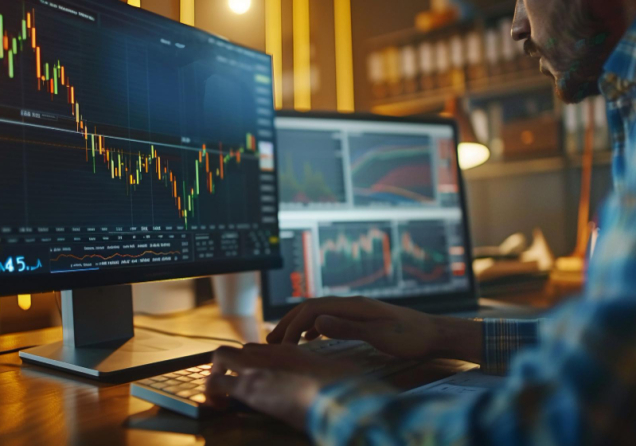What's the Difference Between a Demo and a Live Trading Account?
You’ve crushed it in your demo account, consistent wins, flawless executions, maybe even a little overconfidence. However, when you switch to live trading, everything falls apart. Why? Here’s the hard truth, 90% of traders lose money in live markets, yet most perform well in demo mode. The difference? Real money brings real emotions.
Demo trading is like playing a video game, no fear, no consequences. Live trading? Your brain switches to panic mode at the first loss. Things like slippage, spreads, and emotions don't matter in demo accounts, but they'll destroy your strategy when you're trading with real money. If you've ever wondered why demo success doesn't lead to live profits, this breakdown will show you the main differences and how to close that gap.
Let's get into it.
What Is a Demo Trading Account?
A demo trading account is a training account provided by brokers to trade with virtual money in a market that perfectly mimics the live one. It's intended to teach traders, especially novices, how to utilize a trading platform, experiment with strategies, and familiarize themselves with how markets operate without losing real money.
Brokers make it seem real by utilizing live or slightly delayed market prices, so you can see price action, place orders, and utilize platform features just like with a live account.
Key features of demo accounts are:
- Mock money for practicing risk-free
- Live or delayed market prices
- Full access to trading functionality and tools
- Demo accounts are perfect for building confidence and experimenting with strategies before trading using real money.
Demo accounts are ideal for gaining confidence and practicing strategies before switching to live trading.
What Is a Live Trading Account?
A live trading account is a brokerage account where you use real money to buy and sell financial assets. Unlike a demo account, the profits and losses are real, so every trade affects your money. The point of a live account is to trade in the actual market. Beyond just knowing the technical stuff, live trading brings emotional challenges, fear, greed, and pressure often change how you make decisions when your real money is on the line.
It's not only about having a good strategy. Success with a live account also depends on controlling your emotions when there's real risk involved.
Key Differences Between Demo and Live Trading Accounts
Demo and live trading accounts look much the same, but there are some important differences when it comes to actual money. In a demo account, emotions like fear and greed are less intense since no real money is at stake. However, in a live account, the pressure of risking real capital can affect decision-making, discipline, and emotional control, making it a crucial step in a trader’s growth.

Deciding whether to open a live or demo account with top-tier broker Pepperstone
Risk & Emotional Toll
Demo trading involves no money risk and therefore, traders make no-risk decisions with no fear of losing capital. Live trading involves actual stakes, and that creates emotional stress that can distort your judgment. This emotional difference is what often separates successful traders from beginners.
While demo trading is great for building skills and testing strategies, only live trading reveals how well you can manage pressure, stick to your plan, and handle losses without panic. Developing emotional discipline is just as important as technical knowledge in real market conditions.
Execution & Slippage
Demo accounts will act upon your orders instantly under perfect conditions. Live trading will have slippage, delay in execution, or partial fills included, especially when the market is volatile. These differences can impact your strategy's real-world performance.
A trading system that works flawlessly in a demo environment might face unexpected challenges in live markets due to slippage or delayed order execution. That's why it's essential to test strategies in both settings and adjust expectations accordingly.
Market Liquidity & Spreads
Spreads and liquidity look perfect in demo accounts. But with a live account, you must endure real market conditions, like wider spreads and varying liquidity, which affects the spread your trades pay.
In live trading, especially during major news events or low-volume periods, spreads can widen significantly, and liquidity may dry up, causing delays or unfavorable trade fills. These real-world factors can directly impact profitability and risk, making it vital for traders to experience and adapt to them beyond the demo environment.
Psychological Biases
Traders become too confident in demo accounts because there are no real stakes. When it comes to actual trading, fear and greed creep in and make it very hard to stick with your plan.
This shift in mindset can lead to impulsive decisions, overtrading, or abandoning well-tested strategies out of panic or excitement. Recognizing and managing these psychological biases is a key part of becoming a disciplined trader, something that only live trading truly exposes and helps you train over time.

Do Demo Accounts Prepare You for Live Trading?
Demo accounts are ideal for beginners. They enable you to simulate how a trading platform works, experiment with different tools, and test strategies without losing any capital. This makes you confident and familiarizes you with the technical side before you ever trade real money.
But demo trading isn't without certain obvious limitations.
Since you're not with real money, it won't teach you how to deal with the emotions that accompany real financial risk. When you're in a demo account, you don't feel the threat of losing cash or the anxiety of having to make profitable trades, two gigantic barriers when you're trading live. Furthermore, demo accounts accustom you to the technical aspect of trading, but not the emotional one of real market conditions.
How to Make a Smooth Transition from Demo to Live Trading
The transition from demo to live trading is where reality bites. To make the transition successfully, follow the following important steps:
Start Small
Open a live account with minimal capital, sufficient enough to make you serious about trading, yet insufficient enough to cut into your finances in case you lose it. This gets you used to real market conditions without subjecting you to too much stress.
Keep a Trading Journal
Record every trade, including your entry and exit, the reason you entered, and your state of mind. Over time, the journal allows you to see what you're doing right, fix your mistakes, and optimize your strategy.
Manage Your Emotions
Real money trading invokes greed, fear, and frustration. Learn how to keep calm after losing trades, do not make sudden decisions based on emotions, and stick to your plan even when you are making losing trades.
Practice Good Risk Management
Save your capital by setting stop-loss orders and capping your risk per trade at no more than 1–2% of your account. This will allow you to weather bad times and acquire some longevity in the game and, over time, build up your account. Going live trading slowly and carefully bridges the gap between demo practice and real-life trading, making less expensive mistakes and gaining steady persistence over time.

Common Mistakes When Moving from Demo to Live Trading
Moving from demo to live trading can catch off guard traders with problems they never found during simulation mode. Some of the most common mistakes to watch out for are:
Overtrading due to Overconfidence
Success on a demo account can lead to overconfidence. The majority of traders go into live trading too aggressively, trading too frequently, or taking bigger position sizes without adjusting their risk accordingly, typically leading to rapid losses.
Ignoring Slippage and Liquidity
In demo accounts, trades will usually happen right away at the very same prices you observe. Real markets are a different ball game, though—you see slippage, latency, and liquidity problems, especially when markets are moving rapidly. Not accounting for these in your strategy can mess up your trades in ways you did not expect.
Underestimating Psychological Pressure
The mental difference between demo trading and live trading is huge. Fear of losing real money, second-guessing, and rash decision-making usually appear for the first time when you start live trading. Traders who can't handle this pressure might lose their strategy or make wrong choices. Avoiding these mistakes is all about understanding that simulation is not actually reality, and getting yourself ready mentally and strategically in advance of engaging in trading with actual funds.
Final Thought
It is important to comprehend the difference between demo and live trading accounts in becoming a great trader. Demo accounts are great for learning about how the platforms are used and paper strategy testing without capital loss, but live trading comes with real emotions, market intricacies, and actual loss of money.
Practice in demo trading, but never mind, this is just the beginning. Stay disciplined, manage your risk in order, and go into live trading with a good plan and a clear head. Start with a demo account, but don't stay there too long. Use these pointers to trade your way confidently into the live markets and thrive.
Top-Tier Trusted Brokers
The table below contains links to 3rd party websites of our top partners from whom we receive compensation at no additional cost to you.






























